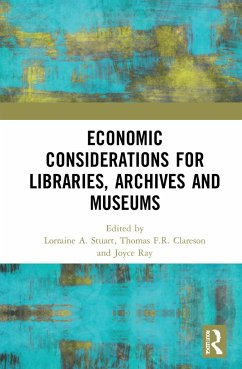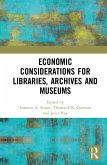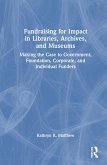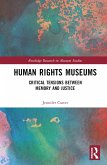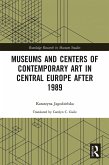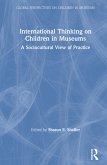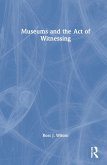Economic Considerations for Libraries, Archives and Museums
Herausgeber: Stuart, Lorraine A.; Ray, Joyce; Clareson, Thomas F. R.
Economic Considerations for Libraries, Archives and Museums
Herausgeber: Stuart, Lorraine A.; Ray, Joyce; Clareson, Thomas F. R.
- Broschiertes Buch
- Merkliste
- Auf die Merkliste
- Bewerten Bewerten
- Teilen
- Produkt teilen
- Produkterinnerung
- Produkterinnerung
Economic Considerations for Libraries, Archives and Museums provides insight into the economics of collaboration across Libraries, Archives, and Museums (LAMs) and cultural heritage funding.
Andere Kunden interessierten sich auch für
![Economic Considerations for Libraries, Archives and Museums Economic Considerations for Libraries, Archives and Museums]() Economic Considerations for Libraries, Archives and Museums198,99 €
Economic Considerations for Libraries, Archives and Museums198,99 €![Fundraising for Impact in Libraries, Archives, and Museums Fundraising for Impact in Libraries, Archives, and Museums]() Kathryn K. MatthewFundraising for Impact in Libraries, Archives, and Museums199,99 €
Kathryn K. MatthewFundraising for Impact in Libraries, Archives, and Museums199,99 €![Reculturing Museums Reculturing Museums]() Doris B. AshReculturing Museums199,99 €
Doris B. AshReculturing Museums199,99 €![Human Rights Museums Human Rights Museums]() Jennifer CarterHuman Rights Museums198,99 €
Jennifer CarterHuman Rights Museums198,99 €![Museums and Centers of Contemporary Art in Central Europe after 1989 Museums and Centers of Contemporary Art in Central Europe after 1989]() Katarzyna Jagodzi¿skaMuseums and Centers of Contemporary Art in Central Europe after 198965,99 €
Katarzyna Jagodzi¿skaMuseums and Centers of Contemporary Art in Central Europe after 198965,99 €![International Thinking on Children in Museums International Thinking on Children in Museums]() International Thinking on Children in Museums198,99 €
International Thinking on Children in Museums198,99 €![Museums and the Act of Witnessing Museums and the Act of Witnessing]() Ross J. WilsonMuseums and the Act of Witnessing198,99 €
Ross J. WilsonMuseums and the Act of Witnessing198,99 €-
-
-
Economic Considerations for Libraries, Archives and Museums provides insight into the economics of collaboration across Libraries, Archives, and Museums (LAMs) and cultural heritage funding.
Hinweis: Dieser Artikel kann nur an eine deutsche Lieferadresse ausgeliefert werden.
Hinweis: Dieser Artikel kann nur an eine deutsche Lieferadresse ausgeliefert werden.
Produktdetails
- Produktdetails
- Verlag: Routledge
- Seitenzahl: 240
- Erscheinungstermin: 31. Mai 2023
- Englisch
- Abmessung: 234mm x 156mm x 13mm
- Gewicht: 371g
- ISBN-13: 9781032129822
- ISBN-10: 1032129824
- Artikelnr.: 67822855
- Herstellerkennzeichnung
- Libri GmbH
- Europaallee 1
- 36244 Bad Hersfeld
- gpsr@libri.de
- Verlag: Routledge
- Seitenzahl: 240
- Erscheinungstermin: 31. Mai 2023
- Englisch
- Abmessung: 234mm x 156mm x 13mm
- Gewicht: 371g
- ISBN-13: 9781032129822
- ISBN-10: 1032129824
- Artikelnr.: 67822855
- Herstellerkennzeichnung
- Libri GmbH
- Europaallee 1
- 36244 Bad Hersfeld
- gpsr@libri.de
Associate Prof. Lorraine A. Stuart is Head of Special Collections/Curator of Historical Manuscripts and Archives at the University of Southern Mississippi. Previously, she directed the archival program at the Museum of Fine Arts, Houston from 1995-2016. Thomas F. R. Clareson is Senior Consultant for Digital & Preservation Services at LYRASIS, consulting on preservation, disaster preparedness, digitization, funding, strategic planning, and arts and cultural advocacy. He also serves as Director of the Performing Arts Readiness project. Joyce Ray, Ph.D., is Senior Lecturer and Program Coordinator of the Digital Curation program at Johns Hopkins University's Division of Advanced Academic Programs, Museum and Heritage Studies.
List of Figures and Tables; List of Contributors; Acknowledgements;
Introduction; Section I - The Digital Environment: Chapter 1 Collaboration
among Libraries, Archives, and Museums in the United States: 1999-2019;
Chapter 2 A Case Study on the Future of Digital Technologies in Libraries,
Archives and Museums: Collecting Institutions in the Network Society;
Chapter 3 How and Why the European Union Promotes Collaboration to Connect
Museums, Libraries, and Archives with Online Users Across Europe and Around
the World: Europeana; Section II - Collaborative Models: Chapter 4 Lessons
Learned from Digital Collaborations: Standards and Descriptive Practices;
Chapter 5 Tribal Archives, Libraries, and Museums: ATALM A Practical Model
for Local Collaboration; Section III - Taking a Look at LAM Education: What
Works, What Could Work Better: Chapter 6 Libraries, Archives and Museums of
the Future: Educational Programs in Europe; Chapter 7 Promoting
Collaboration, Recognizing the Power of Information and Object in
Professional Identity: Educating Library, Archives, and Museum
Professionals in the United States; Section IV - Funding and
Sustainability: Global Reach, Local Impact: Chapter 8 A Case Study for
Collective Action Through Federal Grant Funding: Grant Programs that Saved
History; Chapter 9 Funding, Sustainability, and Cross-Institutional
Collaboration; Chapter 10 Collaboration North of the (U.S.) Border; Chapter
11 Banding Together Against Disasters: The Benefits of Collaboration in
Times of Crisis; Section V - The Cultural Economy: Chapter 12 The Value of
Archives and Authenticity in Exhibitions of Visual Culture; Chapter 13
Grassroots Collaborative Models for Visibility and Advocacy: Building on
"LA as Subject"; Chapter 14 The Role of Libraries, Archives and Museums in
the Cultural Economy - Perception, Documentation, and Vision for the
Future; Index.
Introduction; Section I - The Digital Environment: Chapter 1 Collaboration
among Libraries, Archives, and Museums in the United States: 1999-2019;
Chapter 2 A Case Study on the Future of Digital Technologies in Libraries,
Archives and Museums: Collecting Institutions in the Network Society;
Chapter 3 How and Why the European Union Promotes Collaboration to Connect
Museums, Libraries, and Archives with Online Users Across Europe and Around
the World: Europeana; Section II - Collaborative Models: Chapter 4 Lessons
Learned from Digital Collaborations: Standards and Descriptive Practices;
Chapter 5 Tribal Archives, Libraries, and Museums: ATALM A Practical Model
for Local Collaboration; Section III - Taking a Look at LAM Education: What
Works, What Could Work Better: Chapter 6 Libraries, Archives and Museums of
the Future: Educational Programs in Europe; Chapter 7 Promoting
Collaboration, Recognizing the Power of Information and Object in
Professional Identity: Educating Library, Archives, and Museum
Professionals in the United States; Section IV - Funding and
Sustainability: Global Reach, Local Impact: Chapter 8 A Case Study for
Collective Action Through Federal Grant Funding: Grant Programs that Saved
History; Chapter 9 Funding, Sustainability, and Cross-Institutional
Collaboration; Chapter 10 Collaboration North of the (U.S.) Border; Chapter
11 Banding Together Against Disasters: The Benefits of Collaboration in
Times of Crisis; Section V - The Cultural Economy: Chapter 12 The Value of
Archives and Authenticity in Exhibitions of Visual Culture; Chapter 13
Grassroots Collaborative Models for Visibility and Advocacy: Building on
"LA as Subject"; Chapter 14 The Role of Libraries, Archives and Museums in
the Cultural Economy - Perception, Documentation, and Vision for the
Future; Index.
List of Figures and Tables; List of Contributors; Acknowledgements;
Introduction; Section I - The Digital Environment: Chapter 1 Collaboration
among Libraries, Archives, and Museums in the United States: 1999-2019;
Chapter 2 A Case Study on the Future of Digital Technologies in Libraries,
Archives and Museums: Collecting Institutions in the Network Society;
Chapter 3 How and Why the European Union Promotes Collaboration to Connect
Museums, Libraries, and Archives with Online Users Across Europe and Around
the World: Europeana; Section II - Collaborative Models: Chapter 4 Lessons
Learned from Digital Collaborations: Standards and Descriptive Practices;
Chapter 5 Tribal Archives, Libraries, and Museums: ATALM A Practical Model
for Local Collaboration; Section III - Taking a Look at LAM Education: What
Works, What Could Work Better: Chapter 6 Libraries, Archives and Museums of
the Future: Educational Programs in Europe; Chapter 7 Promoting
Collaboration, Recognizing the Power of Information and Object in
Professional Identity: Educating Library, Archives, and Museum
Professionals in the United States; Section IV - Funding and
Sustainability: Global Reach, Local Impact: Chapter 8 A Case Study for
Collective Action Through Federal Grant Funding: Grant Programs that Saved
History; Chapter 9 Funding, Sustainability, and Cross-Institutional
Collaboration; Chapter 10 Collaboration North of the (U.S.) Border; Chapter
11 Banding Together Against Disasters: The Benefits of Collaboration in
Times of Crisis; Section V - The Cultural Economy: Chapter 12 The Value of
Archives and Authenticity in Exhibitions of Visual Culture; Chapter 13
Grassroots Collaborative Models for Visibility and Advocacy: Building on
"LA as Subject"; Chapter 14 The Role of Libraries, Archives and Museums in
the Cultural Economy - Perception, Documentation, and Vision for the
Future; Index.
Introduction; Section I - The Digital Environment: Chapter 1 Collaboration
among Libraries, Archives, and Museums in the United States: 1999-2019;
Chapter 2 A Case Study on the Future of Digital Technologies in Libraries,
Archives and Museums: Collecting Institutions in the Network Society;
Chapter 3 How and Why the European Union Promotes Collaboration to Connect
Museums, Libraries, and Archives with Online Users Across Europe and Around
the World: Europeana; Section II - Collaborative Models: Chapter 4 Lessons
Learned from Digital Collaborations: Standards and Descriptive Practices;
Chapter 5 Tribal Archives, Libraries, and Museums: ATALM A Practical Model
for Local Collaboration; Section III - Taking a Look at LAM Education: What
Works, What Could Work Better: Chapter 6 Libraries, Archives and Museums of
the Future: Educational Programs in Europe; Chapter 7 Promoting
Collaboration, Recognizing the Power of Information and Object in
Professional Identity: Educating Library, Archives, and Museum
Professionals in the United States; Section IV - Funding and
Sustainability: Global Reach, Local Impact: Chapter 8 A Case Study for
Collective Action Through Federal Grant Funding: Grant Programs that Saved
History; Chapter 9 Funding, Sustainability, and Cross-Institutional
Collaboration; Chapter 10 Collaboration North of the (U.S.) Border; Chapter
11 Banding Together Against Disasters: The Benefits of Collaboration in
Times of Crisis; Section V - The Cultural Economy: Chapter 12 The Value of
Archives and Authenticity in Exhibitions of Visual Culture; Chapter 13
Grassroots Collaborative Models for Visibility and Advocacy: Building on
"LA as Subject"; Chapter 14 The Role of Libraries, Archives and Museums in
the Cultural Economy - Perception, Documentation, and Vision for the
Future; Index.

